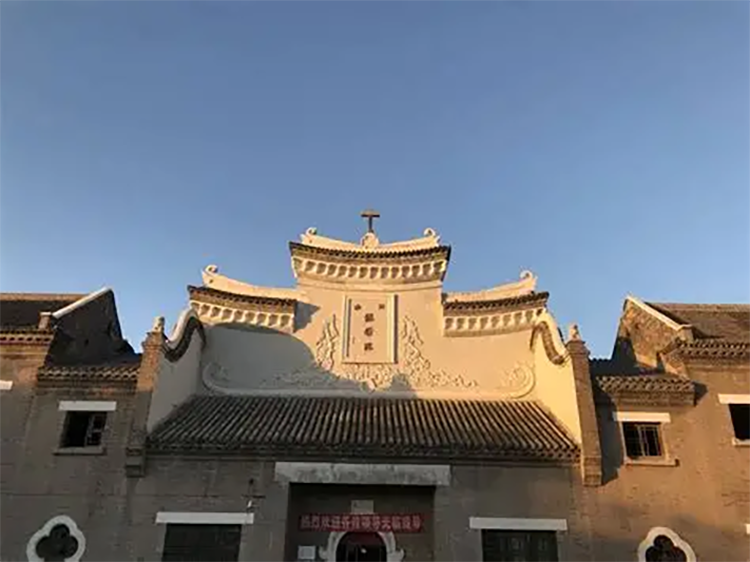Kaifeng’s Henan Catholic Seminary: A Religious Heritage Site in China Showcasing Sino-Western Architecture
In the winding lanes of Kaifeng, the “City of Eight Dynasties,” stands a storytelling complex: the Henan Catholic Seminary. When morning light filters through arched windows onto timeworn bricks, and Flemish-style pitched roofs silhouette against a symmetrical Chinese courtyard, every stone recalls the 1930s dialogue between East and West. Unlike traditional temple eaves, this provincially protected site combines hybrid architectural beauty and a weighty history of religious education, offering modern travelers a unique window into modern China’s religious syncretism.
1. A Sino-Western Architectural Poem
As the cradle of Catholic clergy in Central China during the Republican era, the Henan Seminary itself reads like a three-dimensional history book. Belgian missionaries modeled the campus on European seminaries but subtly integrated Eastern philosophy of harmony between heaven and humanity. The main complex follows a strict central axis symmetry, while two-story brick-and-wood arched windows and steep western roofs reflect distinctive Flemish features.
The most striking feature is the corridor’s play of light and shadow: a 60-meter arcade with repeating pointed arches creates deep visual perspective. In the afternoon, slanting sunlight paints rhythmic bands across the floor—designed both for meditative walks and in keeping with Western cloister traditions. Wooden screens carved with wan-shaped motifs flanking the central hall discreetly reveal respect for local aesthetics.
2. A Time Capsule from Classroom to Sanctuary
Passing through the main doorway carved with grapevine reliefs feels like stepping back into the 1930s. The second-floor teaching quarter preserves its original layout:
– The Latin classroom still holds a black cast-iron stove and a crucifix on the lectern, bearing witness to seminarians studying scholastic philosophy.
– The small chapel’s stained glass is incomplete, yet the golden “INRI” inscription above the altar remains clear.
– Dormitory doors barely 1.5 meters wide are said to have been built to cultivate clerical humility.
At its peak, the seminary trained about 80 local priests each year. Walking the long corridor today, one can almost hear the cadence of Scripture read in the Henan dialect—an audible sign of the Kaifeng diocese’s indigenization of faith.
3. Decoding the Architectural Symbols
Attentive visitors will notice many hidden cultural symbols:
– The dripstones at the courtyard base use traditional Chinese components but are carved with olive branch motifs from the Bible.
– Under Baroque volutes on the gable, you can find brick carvings alluding to Daoist “hidden immortals.”
– Wrought-iron grape patterns on stair railings symbolize Christ’s blood while nodding to Henan’s local winemaking traditions.
These seemingly contradictory combinations are living evidence of the Republican-era movement to adapt Christianity to local culture. Foreign missionaries realized that for the Gospel to take root in Central China, the church had to “wear Chinese clothing.”

4. Immersive Visit Guide
Best times to visit:
– Morning 8–10 AM (perfect light through the arcades for photography)
– Sunday afternoons (you may encounter local worshippers praying in the small surviving chapel)
Three-step cultural experience:
1. Find the bilingual Bible stone carving in the northwest corner (the most intact example on site).
2. Touch the repair marks on the brickwork—original grey bricks date to the Republican era; red bricks mark 1950s repairs.
3. Compare the carved capitals on the east and west sides of the central hall (the west displays Corinthian style; the east blends a lotus base).
Note: The second-floor “Kaifeng Diocese History Room” houses a 1932 opening ceremony photograph where Chinese seminarians in changpao stand shoulder-to-shoulder with foreign priests—an invaluable snapshot of modern religious history.
5. Practical Information and Etiquette Tips
– Address: Caoshi Street, Shunhe Hui District, Kaifeng (200 meters north of the intersection with Jiefang Avenue)
– Opening hours: Tuesday–Sunday, 9:00–17:00 (free admission, no reservation required)
– Getting there: Take Bus No.3 to “Xueyuan Men” stop, or cycle 15 minutes from Qingming Riverside Landscape Garden (Qingming Shanghe Park)
– Etiquette: Although not an active parish, maintain silence when worshippers pray; photography of architectural details is welcome, but avoid intrusive shots during religious activities.
Nearby visits: Combine this stop with the Kaifeng Jewish History Museum (10-minute walk) and the Northern Song bridge ruins (8-minute bike ride) for a half-day “East-West Civilizations” itinerary.

When the sunset gilds the seminary’s cross, you begin to understand why UNESCO experts call it “a more vivid textbook of religious fusion than many cave temples.”
This complex is not just a site to see; it is a key—opening imagination about cultural tolerance and the creative energy of a turbulent yet inventive era. Next time you visit Kaifeng, beyond soup-filled buns and the famous Riverside Painting scrolls, set aside an afternoon for this silent “cultural hybrid.”


